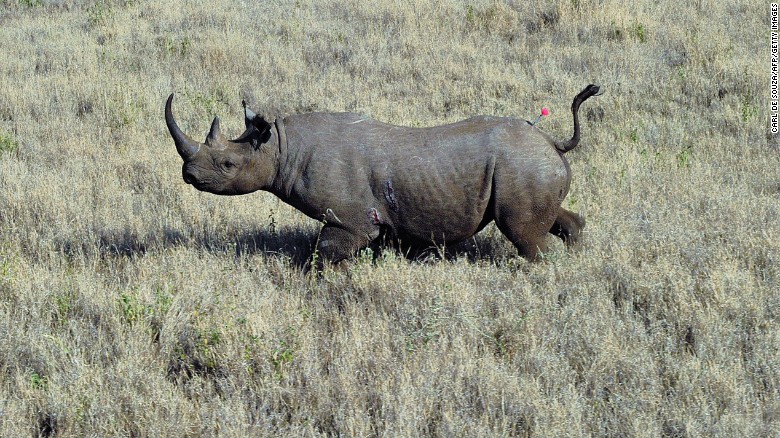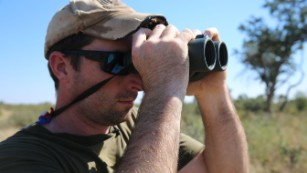Black rhino hunt: Why killing one bull is worth it for conservation

Rhino hunter defends killing an endangered animal 03:45
Story highlights
- The removal of few surplus black rhino bulls can enhance rhino conservation, argue the authors
- Benefits include limiting inbreeding and generating funds that go back into conservation, they say
Editor's note: Dr Mike Knight is the Chairman of the International Union for Conservation of Nature (IUCN) Species Survival Commission's African Rhino Specialist Group (AfRSG) and the South African Development Community Rhino Management Group (SADC RMG). Dr Richard Emslie is the AfRSG Scientific Officer and also a SADC RMG member. All views expressed in this commentary are solely theirs.
(CNN)It
is often hard for people to understand the rationale for the sport
hunting of an endangered rhino species, especially at a time when
poaching has been increasing.
Although
it seems counter-intuitive, the removal of a few surplus male black
rhinos can enhance rhino conservation -- in addition to generating much
needed revenue to protect and conserve rhinos.

The journey to kill a black rhino 03:07
Since 2004, both Namibia and South Africa have each had annual hunting quotas of up to five black rhino bulls approved by the Convention on International Trade in Endangered Species (CITES -- an organization formulated by the IUCN).
Only
specific, surplus males are hunted, with each case considered on its
merits. Based on research by the IUCN and SADC RMG, conservation reasons
for hunting black rhinos include:
Preventing inbreeding
Limiting
inbreeding by removing older bulls that have dominated the breeding for
many years. Inbreeding reduces genetic diversity and increases the
chances of poor reproductive success -- both critical in successful
small population management, according to research we've seen by Bob
Lacy of the Chicago Zoological Society.
Population growth
Our
black rhino monitoring data shows that black rhino female calving
success significantly improve as the ratio of adult males to females in a
population declines. This is compounded by a significantly (53%) male
biased average black rhino sex ratio at birth.
Also,
some rhino populations have a higher number of males than others, and
those with more females are unwilling to take any of these excess males.
Simply leaving excess males in populations eventually results in
increased fighting and mortalities and slower population growth rates.
Improving breeding performance
Black
rhino breeding performance improves when better quality nutrition is
available for breeding females. The removal of an older surplus bull can
free up food resources for females, potentially enhancing breeding.
Very occasionally, an infertile but dominant bull can negatively impact on breeding. The hunting of such a bull results in the cows conceiving again and a net gain in rhino numbers.
Stopping bulls killing each other
Older
bulls are often pushed to peripheral areas by other younger stronger
bulls. Bulls pushed into communal areas north of Etosha National Park in
Namibia are vulnerable to poaching if not removed.
The
Namibian Ministry of Environment and Tourism (MET)'s's Chief
Conservation Scientist in charge of Wildlife Research, Pierre du Preez,
has found that introducing such older bulls, older than 25 years, back
into established rhino populations has resulted in fighting mortalities or break outs.
In
one case, according to Preez, the MET reports that one bull broke out
of Etosha three times despite being released 60km inside the park. As a
result, MET has stopped relocating such older bulls back into Etosha, so
their limited resources can be better spent on rhino conservation and
protection.
These older animals have
been taken to an alternative site as nominated candidates for hunting
and the bull hunted by the Dallas Safari Club auction winner was one
such animal, aged at least 29 -- the life span of black rhinos is 35 to 40 years.
Occasionally, these bulls have killed other rhinos. One cannot simply export such problem animals elsewhere.
Trophy hunting positives
Preez tells us that the increased cost of Namibian efforts to combat escalating poaching are significantly impacting on budgets. Any additional revenue that can be allocated to anti-poaching efforts is especially welcome at this time.
The Namibian Game Products Trust Fund (GPTF) established in 1997 has a proven track record of channeling revenue from wildlife-use back into conservation.
In
the case of Namibia's black rhino hunts, all proceeds after expenses
(including from the Dallas Safari Club auction) go into an account
within the GPTF that can only be used for approved rhino conservation projects.
Trophy hunting of South Africa's white rhinos commenced in 1968 when there were only 1,800 animals with numbers increasing more than ten-fold ever since. Since
the start of limited black rhino hunting in both Namibia and South
Africa in 2004, total numbers of black rhinos in the two countries have
increased by an estimated 51% (although this cannot be attributed to
hunting).
Not a single country has
hunted five black rhino bulls per year -- the quota approved by CITES,
indicating that conservation, rather than profit, has been driving the
hunting. The maximum quotas approved currently represent only 0.24% and
0.29% of the national rhino population in each country. Clearly, rhino
hunting levels have also been sustainable.
We've
found that it has often been suggested that the amount that is paid at
an auction to hunt a rhino should, instead, be paid towards saving the
animal. This does not consider who will pay the expensive costs of the
animal, its capture and relocation, its relocation site, and the ongoing
management, monitoring and protection.
We
feel that the money and land required to look after "rescued surplus
males" could be better spent conserving existing rhino populations.
Focusing on the population rather than one individual bull is wiser in
addressing the far bigger problem of escalating poaching.
In the light of all this evidence, the member governments and conservation organizations of the IUCN agreed in 2012
on "the important role that commercial wildlife enterprises, including
trophy hunting, has played in generating incentives for conservation and
stimulating population increases of rhinos ... in Africa."

ไม่มีความคิดเห็น:
แสดงความคิดเห็น